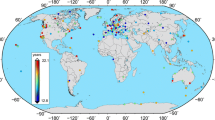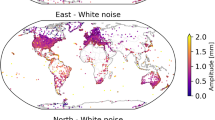Abstract
The noise spectrum in DORIS ground- station motion is investigated by means of the Allan variance method applied to the decomposition of the 3D signal into its principal components in the time domain. Sets of weekly position time-series from 1994 to 2005 derived by three IDS Analysis Centres (IGN-JPL, INASAN, and LEGOS-CLS) for 119 stations at 69 sites are considered. The observing satellites are SPOT-2, SPOT-3, SPOT-4, and SPOT-5, TOPEX/Poseidon, and ENVISAT. Annual and semi-annual perturbations, as well as the 117.3-day term associated with the TOPEX/Poseidon orbit, are found at most stations. Their amplitudes reach up to 19.3, 23.7, and 13.3 mm, respectively, for the three analysis centres (ACs). When corrected for these components and a linear drift, the time-series dominantly show white noise (WN) at the 10–45mm level the noise level is the highest in the East direction, probably in connection with the high orbit inclinations. The noise level is minimum for the high latitude stations, mostly and intensively observed by the SPOT satellites, and the determination of the noise type is unclear; longer observation spans would be needed to decide between interannual variations and flicker noise. The improvement in positioning due to the DORIS constellation extension from three to five satellites in 2002, and the network rejuvenation program initiated in 2000, results in a decrease of the noise level by a factor of 1.7 in a WN context, both before and after the changes. One example of the benefit of studying the signal in the time eigenspace domain is the detection of anomalously large WN in the East direction for station HBKB (Hartebeesthoek, Africa) that masks the above-mentioned improvement. Studying the projection on the local frame of the second and third time-eigenspace components, a noise excess is detected in the North direction for some of the ACs. Station stability derived from our time-series analysis confirms, in general, the expected performance based on the careful technical review of the station components (antenna, pillar, etc.). The respective merits of our noise qualification method, based on direct time-series analysis in the time-eigenspace domain without any a priori statistical model, in comparison with other methods, such as the selection of a mixed-noise model by maximum likelihood estimation, are discussed.
Similar content being viewed by others
References
Allan DW (1966). Statistics of atomic frequency standards. IEEE Trans 54:221–231
Allan DW (1987). Time and frequency (time-domain) characterization, estimation, and prediction of precision clocks and oscillators. IEEE Trans 34:647–654
Altamimi Z, Sillard P, Boucher C (2002). ITRF2000: a new release of the International Terrestrial Reference Frame for earth science applications. J Geophys Res 107(B10):2214. DOI 10.1029/2001JB000561
Azoubib J (1974) Caractérisation des fluctuations aléatoires d’un processus temporel par la variance d’Allan. Report 74/7. Bureau International des Poids et Mesures (BIPM), Sèvres
Baccini A, Besse P (1999). Statistique descriptive multidimensionnelle. In: Laboratoire de Statistique et Probabilité publications. Paul Sabatier University, Toulouse
Beutler G, Rothacher M, Schaer S, Springer TA, Kouba J, Neilan RE (1999). The international GPS service (IGS): an interdisciplinary service in support of Earth sciences. Adv Space Res 23(4):631–653. DOI 10.1016/S0273-1177(99)00160-X
Blewitt G, Lavallée D (2002). Effect of annual signals on geodetic velocity. J Geophys Res 107(B7):2145. DOI 10.1029/2001JB000570
Crétaux JF, Soudarin L, Davidson F JM, Gennero MC, Berge-Nguyen M, Cazenave A (2002). Seasonal and interannual geocenter motion from SLR and DORIS measurements: comparison with surface loading data. J Geophys Res 107(B12):2374. DOI 10.1029/2002JB001820
Fagard H (2006) Twenty years of evolution of the DORIS network: from its initial deployment to its renovation. J Geod (in press, same issue). DOI 10.1007/s00190-006-0084-2
Feissel-Vernier M, Le Bail K (2006) Spectral characteristics of the measurement of station motion with GPS. In: Gowey K (ed) IGS Technical Report 2003/04. IGS Central Bureau, Jet Propulsion Laboratory, Pasadena (in press)
Greenhall CA (1991). Recipies for degrees of freedom of frequency stability estimators. IEEE Trans Instrum Meas 40(6):994–999
Howe DA, Allan DW, Barnes JA (1981). Properties of signal sources and measurement methods. In: Proceedings of IEEE 35th annual symposium on frequency control, 27–29 May 1981, pp A1–A47
Hugentobler U, Dach R, Meindl M, Fridez P (2005). Bernese GPS Software Version 5.0. Astronomical Institute University of Berne, Berne
Hugentobler U, Meindl M, Beutler G, Bock H, Dach R, Jäggi A, Urschl C, Mervart L, Rothacher M, Schaer S, Brockmann E, Ineichen D, Wiget A, Wild U, Weber G, Habrich H, Boucher C (2006) CODE IGS Analysis Center Technical Report 2003/04. In: Gowey K (ed) IGS Technical Report 2003/04. IGS Central Bureau, Jet Propulsion Laboratory, Pasadena (in press)
King NE, Svarc JL, Fogleman EB, Gross WK, Clark KW, Hamilton GD, Stiffler CH, Sutton JM (1995). Continuous GPS observations across the Hayward fault, California, 1991–1994. J Geophys Res 100(B10):20271–20284. DOI 10.1029/95JB02035
Kuzin SP, Tatevian SK (2006) Determination of seasonal geocenter variations from DORIS, GPS and SLR data. In: Capitaine (ed) Earth dynamics and reference systems: five years after adoption of the IAU 2000 Resolutions. Proc Journées Systèmes de Référence spatio-temporels (in press)
Langbein JO, Johnson H (1997). Correlated errors in geodetic time series: Implications for time-dependent deformation. J Geophys Res 102(B1):591–603. DOI 10.1029/96JB02945
Le Bail K (2004) Etude statistique de la stabilité des stations de géodésie spatiale. Application à DORIS. 10 Dec 2004. PhD Thesis dissertation in “Dynamique des systèmes gravitationels”, Paris Observatory
Le Bail K, Valette JJ, Zerhouni W, Feissel-Vernier M (2006) Long-term consistency of multi-technique terrestrial reference frames, a spectral approach. In: Tregoning P, Rizos C (eds) Monitoring and Understanding a Dynamic Planet with Geodetic and Oceanographic Tools. Springer, Berlin Heidelberg New York (in press)
Lemoine J-M, Capdeville H (2006) Corrective model for Jason-1 DORIS Doppler data in relation to the South Atlantic Anomaly. J Geod (same issue, in press) DOI 10.1007/S00190-006-0068-2
Mao A, Harrison CGA, Dixon TH (1999). Noise in GPS coordinate time series. J Geophys Res 104(B2):2797–2816. DOI 10.1029/1998JB900033
Morel L, Willis P (2005), Terrestrial reference frame effects on global sea level rise determination from TOPEX/Poséidon altimetric data. Adv Space Res 36(3):358–368. DOI 10.1016/j.asr.2005.05.113
Nikolaidis R (2002) Observation of geodetic and seismic deformation with the Global Positioning System. PhD Thesis dissertation, University of California in San Diego
Papoulis A, Pillai SU (2002) In: International edition. Probability, random variables and stochastic processes, 4th edn. McGraw-Hill, New York, pp 249–250
Pavlis DE, Poulose SG, Rowton SC, McCarthy JJ, Luthcke SB (2000) GEODYN operations manuals. Contractor report Raytheon ITSS, Greenbelt, 15 March 2000
Pearlman MR, Degnan JJ, Bosworth JM (2002). The international laser ranging service. Adv Space Res 30(2):135–143
Penna NT, Stewart MP (2003). Aliased tidal signatures in continuous GPS height time series. Geophys Res Lett 30(23):2184–2187. DOI 10.1029/2003GL018828
Rutman J (1978). Characterization of phase and frequency instabilities in precision frequency sources: fifteen years of progress. Proc IEEE 66:1048–1075
Saporta G (1978) In: TECHNIP (ed) Théories et Méthodes de la Statistique. Institut Français du Pétrole publications, Paris.
Schlueter W, Himwich E, Nothnagel A, Vandenberg N, Whitney A (2002).IVS and its important role in the maintenance of the global reference systems. Adv Space Res 30(2):145–150. DOI 10.1016/S0273-1177(02)00278-8
Sillard P, Boucher C (2001).A review of algebraic constraints in Terrestrial Reference Frame datum definition. J Geod 75(2-3):63–73. DOI 10.1007/s001900100166
Snajdrova K, Boehm J, Willis P, Haas R, Schuh H (2006). Multi-technique comparison of tropospheric zenith delays derived during the CONT02 campaign. J Geod 79(10-11):613–623. DOI 10.1007/s00190-005-0010-z
Soudarin L, Crétaux JF (2006) A model of present-day tectonic plate motions from 12 years of DORIS measurements. J Geod (same issue, in press)
Tavernier G, Fagard H, Feissel-Vernier M, Lemoine F, Noll C, Ries J, Soudarin L, Willis P (2005). The International DORIS Service (IDS). Adv Space Res 36(3):333–341. DOI 10.1016/j.asr.2005.03.102
Tavernier G, Fagard H, Feissel-Vernier M, Le Bail K, Lemoine F, Noll C, Ries J, Soudarin L, Valette JJ, Willlis P (2006) The International DORIS Service: genesis and early achievements. J Geod (same issue, in press)
Webb FH, Zumberge JF (1997). An introduction to GIPSY-OASIS II: precision software for the analysis of data from the Global Positioning System, Internal Publication JPL D-11088. Jet Propulsion Laboratory, Pasadena
Williams SDP (2003). The effect of coloured noise on the uncertainties of rates estimated from geodetic time series. J Geod 76(9-10):483–494. DOI 10.1007/s00190-002-0283-4
Williams SDP, Bock Y, Fang P, Jamason P, Nikolaidis RM, Prawirodirdjo L, Miller M, Johnson DJ (2004). Error analysis of continuous GPS position time series. J Geophys Res 109(B3):B03412. DOI 10.1029/2003JB002741
Williams SDP, Lavallée DA, Penna N (2005) The effect of discontinuities, noise and geophysical signals on the maintenance of a Terrestrial Reference Frame. EOS Trans AGU 86(52), Fall Meet. Suppl., Abstract G32A-02
Willis P, Heflin MB (2004). External validation of the GRACE GGM01C gravity field using GPS and DORIS positioning results. Geophys Res Lett 31(13):L13616. DOI 10.1029/2004GL020038
Willis P, Ries JC (2005). Defining a DORIS core network for Jason-1 precise orbit determination based on ITRF2000: methods and realization. J Geod 79(6-7):370–378. DOI 10.1007/s00190-005-0475-9
Willis P, Haines B, Bar-Sever Y, Bertiger W, Muellerschoen R, Kuang D, Desai S (2003). TOPEX/Jason GPS/ orbit determination in the tandem phase. Adv Space Res 31(8):1941–1946. DOI 10.1016/S0273-1177(03)00156-X
Willis P, Haines B, Berthias JP, Sengenes P, Le Mouel JL (2004). Comportement de l’oscillateur DORIS/Jason au passage de l’anomalie sud-atlantique, Behavior of the DORIS/JASON oscillator over the South Atlantic Anomaly. CR Geoscience 336(9):839–846. DOI 10.1016/j.crte.2004.01.004.
Willis P, Lemoine FG, Soudarin L (2006a) Looking for systematic error in scale from terrestrial reference frames derived from DORIS data. In: Tregoning P, Rizos C (eds) Monitoring and Understanding a Dynamic Planet with Geodetic and Oceanographic Tools. Springer, Berlin Heidelberg New York (in press)
Willis P, Berthias JP, Bar-Sever YE (2006b). Systematic error in the Z-geocenter derived using satellite tracking data: a case study from SPOT-4 DORIS data in 1998. J Geod 79(10–11):567–572. DOI 10.1007/s00190-005-0013-9
Zhang J, Bock Y, Johnson H, Fang P, Genrich JF, Williams S, Wdowinski S, Behr J (1997). Southern California Permanent GPS Geodetic Array: error analysis of daily position estimates and site velocities. J Geophys Res 102(B8):18035–18055. DOI 10.1029/97JB01380
Author information
Authors and Affiliations
Corresponding author
Rights and permissions
About this article
Cite this article
Le Bail, K. Estimating the noise in space-geodetic positioning: the case of DORIS. J Geodesy 80, 541–565 (2006). https://doi.org/10.1007/s00190-006-0088-y
Received:
Accepted:
Published:
Issue Date:
DOI: https://doi.org/10.1007/s00190-006-0088-y




